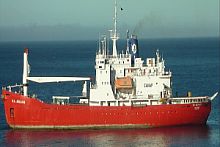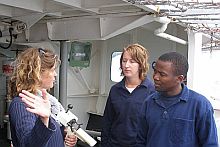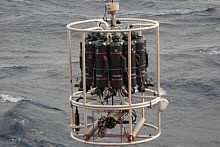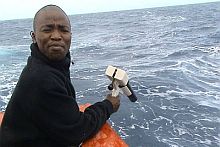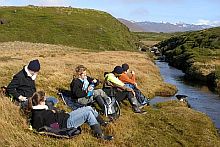A journey of a lifetime
|
- Thomas Mtontsi, Education Outreach Officer, SAEON Egagasini Node
By virtue of being an Education Outreach Officer at the SAEON Egagasini Node for Marine Offshore Systems, I was offered a once-in-a-lifetime opportunity to participate in an oceanographic cruise on the SA Agulhas to learn more about marine offshore systems.
This turned out to be an incredible opportunity to gain hands-on experience and a better understanding of what scientist do and how they arrive at their many theories. It also enabled me to investigate opportunities to integrate scientific research into school science teaching.
This particular oceanographic investigation was to ascertain whether the Conrad Rise,a shallow part in the Southern Ocean, presents an obstruction to the Antarctic Circumpolar Current, the only current that circulates around the world.
It has been the task of the SA Agulhas to take researchers to the Southern Ocean for 30 years. The SA Agulhas is the Department of Environmental Affairs and Tourism's research and supply vessel, which is used by the South African National Antarctic Programme (SANAP) for the transportation of personnel and cargo to its three bases in Antarctica, on Marion and Gough islands.
My impressions?
Having been born in the Karoo and never having been at sea, especially for such a long period, I did not know what to expect. The story of Jonah quickly became part of my operating system. I was excited and scared at the same time!
While the conditions under which the scientific work was done were trying at best, I found the scientists' dedication to investigate the hypothesis amazing. "Starting with the end in mind" was the approach that saw everyone through the process.
Dr Isabelle Ansorge, the chief scientist on the voyage has surveyed the Southern Ocean on numerous occasions and was quick to give guidance and direction when needed. She had prepared a programme to keep us engaged all the way, which included lectures on board.
How I felt being there?
The first few days were the most trying as first-timers always need to accustom themselves to unknown circumstances. A few of us initially felt sea sick, but we quickly got used to the roaring oceans. It was amazing to be surrounded by volumes of water and I admit, scary at times when huge swells and half storms lashed the ship. Home sickness kicked in as we got to the fourth week.
What the trip has shown me
The trip has answered the scientific question that the Conrad Rise indeed forms an obstruction to the Antarctic Circumpolar Current. Personally, I have come to appreciate the developing understanding of the role that the oceans play in our lives. With global warming and climate change receiving a lot of attention, it is key for society to be informed so that we can become engaged in tracking and observing changes.
This presents many opportunities for school science educators. The process of engaging society in the monitoring of changes and preparing them for informed responses is going to have to include everyone, from learners, teachers, students and academics to the layman.
As far as schools are concerned, there is an opportunity to inform curriculum-orientated activities in learning areas such as Natural Sciences, Life Science, Physics, Mathematics and Geography.
I would like to thank SANAP and the Department of Environmental Affairs and Tourism for the wonderful opportunity! The trip has motivated me to share the knowledge I acquired, and this will form the basis of my presentation at the SANAP 2009 Annual Symposium (www.sanap.org.za).


